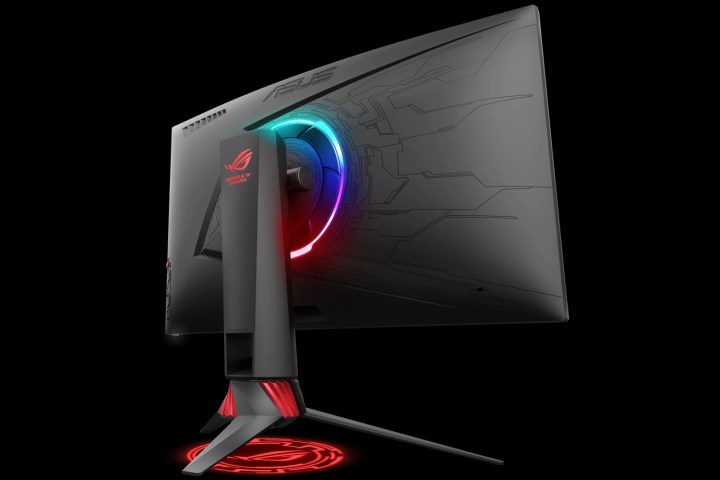
Right now, the three panels aren’t listed on the Republic of Gamers website, thus we have to rely on the company’s latest announcement that doesn’t provide a lot of detail. However, all three will have built-in Aura RGB lighting that’s compatible with Aura Sync, which will synchronize your lighting choices and effects across all supporting devices for a synchronized light show.
As for AMD FreeSync, this technology will synchronize the frame output of a supporting AMD-based graphics chip with the refresh rate of the display. This eliminates screen tearing, stuttering, and viewed input lag that comes when the graphics chip and display are rendering visuals at different rates.
For starters, the Strix XG32V is a curved display with a decent 1,800R curvature, meaning that if the display were to create a complete circle, its radius would be 1,800 millimeters. It’s a bit more “rounded” than a monitor with a 3,000R curvature, which are supposedly more expensive to make, hence the current market saturation of 1,800R solutions.
Note that this particular display sports an IPS panel. That’s short for In-Plane Switching, and promises deep, rich colors and wide viewing angles. This technology is seemingly becoming the standard, replacing the older Twisted Nematic (TN) panel technology that’s typically best suited for gaming due to a higher brightness level and response time (how quick a pixel can change from black to white).
Here’s what we know about this panel so far:
| Screen size: | 31.5 inches |
| Screen type: | IPS |
| Resolution: | 2,560 x 1,440 @ 144Hz |
| Curvature: | 1800R |
| Ports: | 2x DisplayPort 1.2 1x HDMI 2.0 USB 3.1 Gen1 Type-A ports (unknown count) |
Meanwhile, the Strix XG27V is a smaller, 27-inch display with the same curvature. Asus stresses that it’s an “affordable” curved solution although there’s no indication if the display relies on IPS or TN panel technology. However, Asus indicated that this model supports its DisplayWidget software for Windows-based display management.
Here are the scarce details:
| Screen size: | 27 inches |
| Screen type: | Unknown |
| Resolution: | 1,920 x 1,080 @ 144Hz |
| Curvature: | 1,800R |
| Ports: | 1x DisplayPort 1.2 1x HDMI 2.0 1x DVI |

Finally, the Strix XG258 is the only display in the trio lacking a curve. However, it makes up for the curvy loss by offering a high 240Hz refresh rate, meaning it’s capable of rendering 240 frames per second. Typically, a 60-frames-per-second rate is the sweet spot for fluid visuals, and anything above that just makes what you see even more buttery-smooth.
Here’s what we know about this display so far:
| Screen size: | 24.5 inches |
| Screen type: | Unknown |
| Resolution: | 1,920 x 1,080 @ 240Hz |
| Curvature: | None |
| Response time: | 1ms |
| Ports: | 2x DisplayPort 1.2 1x HDMI 2.0 1x HDMI 1.4 |
Again, these three desktop displays won’t arrive until the third quarter of 2017. We expect more hardware details and pricing as we get closer to the retail launch.
Editors' Recommendations
- Asus unveils 20 new gaming laptops with AMD Ryzen 6000
- New Asus ROG Zephyrus G14 gaming laptop goes all-in on AMD


